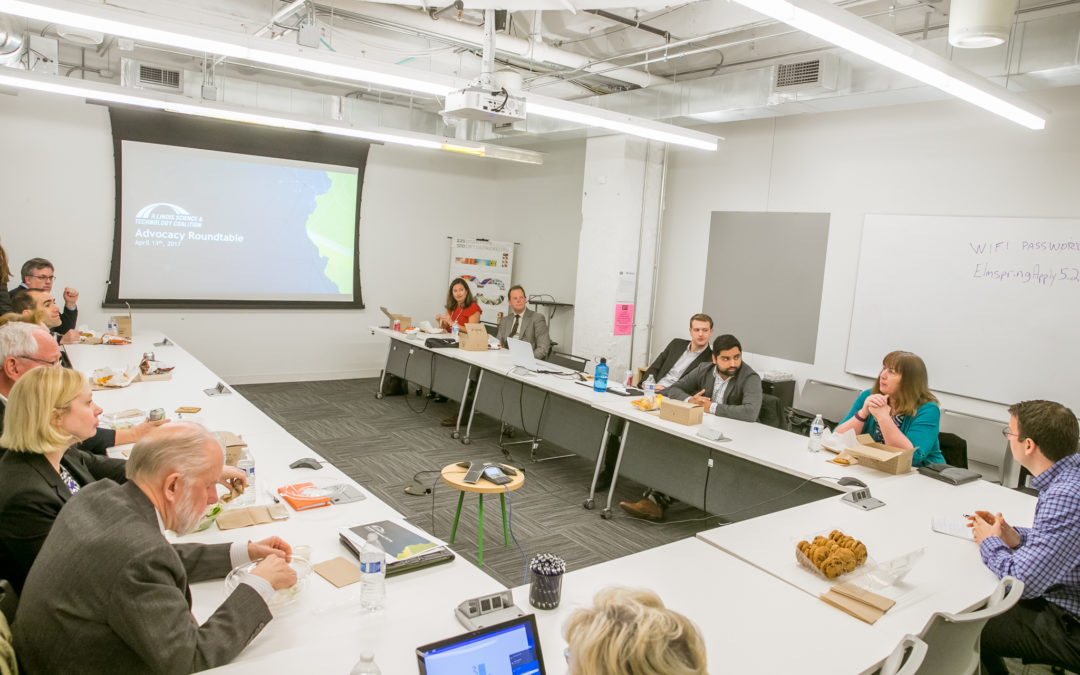Q/A with Dan Berglund, President & CEO, SSTI
 The Federal government plays an instrumental role in advancing science and technology innovation in the United States. Illinois is a top 10 state in receiving critical investment in basic science and R&D, which has been a driver of our economy and led to countless discoveries and innovations.
The Federal government plays an instrumental role in advancing science and technology innovation in the United States. Illinois is a top 10 state in receiving critical investment in basic science and R&D, which has been a driver of our economy and led to countless discoveries and innovations.
To discuss the current state of play for science and technology innovation at the federal level, we sat down with Dan Berglund, President & CEO of SSTI. SSTI is a national, nonprofit organization that strengthens initiatives to create a better future through science, technology, innovation and entrepreneurship. ISTC is a member of SSTI and also among a subset of state organizations that are active on SSTI’s Innovation Advocacy Council.
Q. Can you briefly explain what a skinny budget is, and how President Trump’s proposed budget is unique compared to those of past administrations? What does Trump’s skinny budget say about this administration’s view of the federal government’s role in science and tech innovation?
The skinny budget is the administration’s first outline of their budget proposal that is released early in the first term of a presidency as they work toward developing a full budget proposal later. We anticipate seeing that full budget proposal sometime in May.
The skinny budget put forth by the Trump administration focused on the spending side. In order to bump defense spending by $54 billion, the administration has cut nearly every other federal agency. The skinny budget sends a message that this administration does not view science, technology, innovation and entrepreneurship and the economic development efforts built around those activities as the way to make America great again.
Clearly, the view put forward in this proposal is that the federal government has no role in converting research into commercial products or boosting economic activity in regions. They believe the private sector will handle this all on its own. However, we know that these programs have had a real economic benefit and that the private sector needs the help of the federal government to achieve real economic returns in this arena.
Q. Some of these cuts include regional innovation programs run by both the Economic Development Agency (EDA) and the Small Business Administration (SBA) – including the EDA’s Regional Innovation Strategies i6 Challenge Grant that was recently awarded to mHUB in Chicago. Why are these programs important for promoting innovation?
The cuts contained in the skinny budget are drastic and are not the way to move this country forward. It eliminates the EDA, the Manufacturing Extension Partnership, the Advanced Research Projects Agency-Energy (ARPA-E), and the SBA’s Regional Innovation Clusters program among other programs. These programs, which include the i6 Challenge grant, truly support innovative initiatives at the local level.
These programs serve a catalytic role in encouraging the creation, growth and competitiveness of companies. With more than 75 percent of venture capital flowing to three areas of the country (Bay Area, New York, and Boston), there’s a clear market failure occurring. With small amounts of federal funding, new products and companies are created resulting in good, high-quality jobs.
Q. What major legislative actions are upcoming and how do you believe they will affect the science and tech innovation community (debt ceiling vote, possible sequestration, administrative actions, etc.)?
It’s important to remember that the skinny budget is just the first shot. We have heard from Congress that the president can propose, but we know that ultimately it is up to Congress to pass a budget. What we cannot do is sit on the sidelines and wait for someone else to take up the rallying cry for continued funding for innovation in this country. The administration may be attempting to shock people into accepting cuts that are less drastic. But innovation and advancement in this country is not a negotiating tool. Settling for lesser cuts should not be considered a victory.
Each of the upcoming legislative actions that you asked about have the potential to impact the science and tech innovation community because of agreements that might be reached on broader principles. For example, the vote to raise the debt ceiling used to be a routine vote, but now it could set a framework for the overall amount of funding available for non-defense discretionary funding which is where the federal science, technology, innovation and entrepreneurship support resides.
Also critical will be the release of the full FY 2018 budget (expected in May) and its approval which should occur by September 30. Unless Congress acts to lift spending caps, funding in the FY 2018 budget will fall 16 percent below the 2010 level (when accounting for inflation), which would have a devastating impact on the non-defense discretionary funding.
In addition to the legislative actions that have to occur, we do not know what kind of administrative actions the administration might make on its own. For example, HHS Secretary Price has recommended the federal government should pay significantly lower indirect rates—that action would virtually cripple any research organization’s ability to perform its work.
Q. Can you explain the role of SSTI’s Innovation Advocacy Council and why is a multi-state advocacy effort is important for the science and tech innovation community? How can individuals, nonprofits, and corporations get involved in this or other efforts to preserve and promote funding for innovation?
SSTI’s Innovation Advocacy Council is an initiative we started to better communicate with and educate Congress on innovation issues. So far, we’ve held more than 200 meetings with Congressional offices, provided input on multiple bills and policy proposals, and this work led to $40 million in funding for the Regional Innovation Strategies program.
It is important to have this multi-state effort to show Congress that support for these initiatives and programs is a non-partisan, across-the-country imperative. It doesn’t affect just red states or blue states, these are programs that affect everyone and that build the competitiveness of this country as a whole. We are always stronger together than alone.
We need everyone’s support in this. If anyone is interested in joining the Innovation Advocacy Council, they should contact SSTI. Individuals can contact their representatives and let them know that they believe in the importance of these federal investments and urge them to act to continue and in some cases increase funding. For those that are working in this space, let the media know about the success of your programs.
(interview edited for length and clarity)
Watch
ISTC was proud to join the March for Science, a nonpartisan event part of a coordinated national effort to extend awareness towards science and science education, and to oppose the new administration’s proposed budget cuts to research funding. The Chicago march was keynoted by the Field Museum’s ‘Chief Curiosity Correspondent’ Emily Graslie and Dr. Garry Cooper, CEO of startup Rheaply, which aims to connect scientists for collaboration and mentorship. Several ISTC science advocacy partner organizations were also in attendance, like the Chicago Council for Science and Technology, and graduate student groups from DePaul University, University of Illinois at Chicago, Northwestern University and the University of Chicago. (Video courtesy CBS Chicago)
Learn more
- Trump budget could hit Argonne, Fermilab [Crain’s Chicago Business]
- Trump’s Impact on Chicago Tech [Chicago Inno Beat]
- Why we will march for science [Rep. Bill Foster, D-Ill., opines in The Hill]
- March for Science Chicago draws 40,000 people to ‘defend the basic facts of science’ [Chicago Tribune]
- Foster Leads Congressional Letter Expressing Concern over Trump’s Office of Science Cuts [Press Release]
What we’re reading
- Illinois high school students innovate to solve industry challenges [Video: Fox32 Chicago]
- Nonprofit brings student ideas to some of country’s largest companies [Video: NBC Chicago]
- University of Illinois gains students from California [Crain’s Chicago Business]
- Chicago’s next tech boom: The Maker-Entrepreneur [Chicago Inno]
- mHUB, 2112, MATTER & Polsky Center announce reciprocal membership access to share resources [mHUB blog]
- At Horizon Pharma, corporate social responsibility in the DNA [VIDEO]
- UIC Chancellor Amiridis opines: “How do you grow a university in a state without a budget? [Crain’s Chicago Business]
- Jacob Babcock of startup NuCurrent on ‘stealing’ business from big competitors [Tech Cocktail]
- Why Chicago tech could be a big winner in the race for Illinois governor [Crain’s Chicago Business]
- SiNode Systems wins Sustainable Practice Impact Award for creating batteries that last longer and charge faster [VentureWell]
- Save manufacturing, save the middle class [Decatur Herald-Review]
Illinois Innovation Network Featured Resource: Black Tech Mecca
 The inaugural Black Tech Mecca takes a data driven look at black tech ecosystems and proposes a framework for defining, assessing & developing black tech communities. Supported by Google, CompTIA and Comcast. Access the full report here.
The inaugural Black Tech Mecca takes a data driven look at black tech ecosystems and proposes a framework for defining, assessing & developing black tech communities. Supported by Google, CompTIA and Comcast. Access the full report here.

